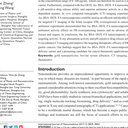Identifying functional residues in arabidopsis thaliana zeta class glutathione S-transferase through screening inactive point mutants.
Parole chiave
Astratto
The functional residues of z-class glutathione S-transferase were identified by screening inactive point mutants from a random mutagenesis library. First, a random mutant library was constructed using error-prone polymerase chain reaction, and then candidate inactive mutants were screened by a high-throughput colorimetric assay. Twenty-five mutants were obtained, and 12 that formed inclusion bodies were discarded. The remaining 13 mutants that expressed soluble protein were used for accurate quantification of enzymatic activity and sequencing. The mutants W15R, C19Y, R22H/K83E, P61S, S73P, S109P, and Q112R were found to have activity lower than 1% of the wild-type and were considered as "inactive mutants", whereas the mutants K83E, Q102R, and L147F still have a large fraction of the activity and were thus considered as "partially inactivated mutants". Molecular modeling experiments disclosed that mutations resulting in inactivation of the enzyme were found in or near the binding pocket, whereas mutations resulting in partial inactivation were distant from both substrates. The role of the residue Ser73 in the enzyme was verified by site-directed mutagenesis. The result suggested that screening inactive point mutants from a random mutagenesis library is an efficient way of identifying functional residues in enzymes.




